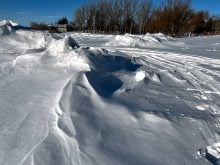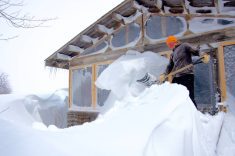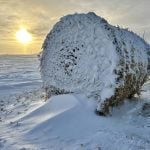Snow or wind, snow or wind, which to write about this week? I think I am going to try to finish up our look at wind. Hopefully by next week we will be in a warmer spring-like pattern, and will be done with the snow, so what better time to write about it? Unfortunately, for those of us who are dealing with too much snow, I think the way this winter has been going, we probably are not done with the snow quite yet.
Before diving back into our look at wind, I think I should remind you of one of the most unique weather-related websites which just happens to show wind speed and direction across the Earth at different altitudes, at earth.nullschool.net.
Read Also

What is perfect Christmas weather?
What is ‘perfect’ Christmas weather on the Prairies? Here’s where you should head this holiday, according to historical weather data.
I am not going to take up a bunch of writing explaining how the site works, but here is a brief overview. This site uses data from weather models to visually show wind speed and direction across the Earth. The site uses both colour and the length of lines to help show the flow and speed of wind. Besides finding this site absolutely fascinating to watch, it is great at showing just how the air flows out of areas of high pressure and spirals into areas of low pressure. You can see how wind shifts occur along frontal lines. Also, by changing the height above the surface measured in hPa, you can also see how wind speeds increase and change as you leave the surface and go up into the atmosphere. Please take some time to play around on this site; you won’t be disappointed. Think of it as your wind homework.
OK, back to our discussion about wind. In the last wind issue we finished up by discussing how friction and the Coriolis force cause winds to curve in certain directions. Areas of low pressure see the wind spiral in toward the centre of the low while areas of high pressure have winds that spiral outward from the centre. We then discussed that with areas of low pressure, that inward movement of air needs to go somewhere, and that direction is upward. It’s this upward flow of air that provides the lift and allows precipitation to form. The problem that we finished with was, where does all that air flowing upward go, and then how does this tie into why we have had so much wind over the last month or so?
Over the past month or two, the general atmospheric flow across Western Canada has been out of the northwest. In the past I have written about how and why this flow pattern, combined with the orientation of the Rocky Mountains, can lead to the development of what is known as lee-side lows, so I won’t go over that again; after all, that discussion would take up a whole article. Due to the nature of this setup, these lows develop and start to draw in air from the surrounding area. In the winter there is a strong temperature difference between the Arctic and subtropical or temperate zones. This temperature difference leads to the development of a strong jet stream. The jet stream is a fast-flowing river of air in the upper atmosphere. Now, remembering that an area of low pressure can only strengthen if all that rising air has somewhere to go, if the developing area of low pressure can align itself with the jet stream or the jet stream lines up with the area of low pressure, then that fast-flowing air above the low can pull or vent away that rising air. This then allows more air to rise, and the low begins to strengthen.
Lift and pull
The flow of the jet stream then pulls the low southeastward toward Manitoba from Alberta. As the jet stream slowly helps to strengthen the low, the low still needs moisture to help it get stronger and to produce precipitation. The strengthening low as it moves toward us begins pulling in air from farther and farther away. To the south of the low it is tapping into warm, moist air and to the north, cold, dry air. As the moist air works into the low, the energy released when the moisture gets pulled upward and cools helps to speed up the rate of its rise. That increase in speed allows the low to pull in more air and moisture, which in turn, speeds things up even further. This process can continue, allowing the low to get stronger and stronger as long as the air at the top of the low is being vented away.
All this increasing lift and pulling in of air equals an increase in wind speed. So, with these Alberta lows or clippers, we see them often strengthen as they move toward us, which gives us these strong southerly winds. As the low moves off to the east, we get the strong northerly winds behind the low. Just like with most things in life, this is a fairly basic view of what is happening as there are other features that come into play such as the pressure difference between the Alberta clipper and the arctic highs, which often drop southward behind the low. A weak area of high pressure would mean lighter winds behind the low; a strong high would mean stronger winds.
As you can hopefully see, it takes the right series of conditions to come together to allow for these lows to develop and bring snow and strong winds. For the last month or so, these conditions just happen to have fallen into place. Will it continue? Hard to say, but the fact that the last couple of clippers have been much weaker might suggest we are seeing a shift away from those perfect conditions.
















